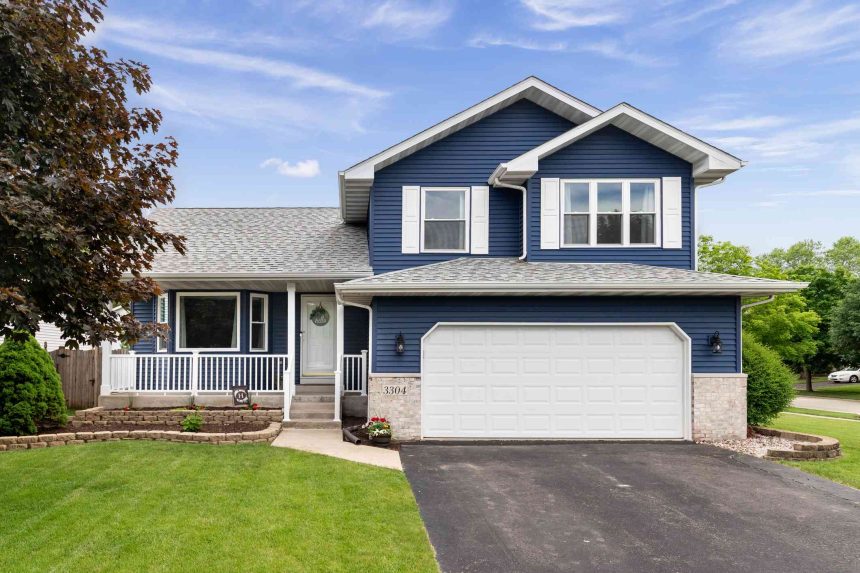If a roof has weakened areas, it can pose a risk to anyone that is working on top of the home and can be targeted by invasive pests to gain entry into the home. However, the roof will continue to protect the home as long as the homeowner keeps up with regular roof maintenance and replaces the roof when it reaches the end of its lifespan.
On average, a roof will last between 25 to 50 years, though this depends on a variety of factors, including the roof material, quality of the installation, and the climate. Learn more about how long a roof will last.
Roof Lifespan by Material
The lifespan of a roof is greatly influenced by the kind of material it is made of. Here are six popular roofing materials and the difference in expected lifespan for each of them.
Asphalt Shingles
photovs / Getty Images
Asphalt shingles are one of the most common options for residential homes. These shingles can be split into two distinct types, including 3-tab asphalt shingles and architectural asphalt shingles.
- 3-tab asphalt shingles are the less durable choice, though this roofing material also costs less than architectural asphalt shingles. This type of asphalt shingle lasts about 20 years before needing to be replaced. This material is lightweight, easy to work with, and resistant to rain, sleet, and snow, though high winds and extreme heat can be a problem.
- Architectural asphalt shingles are intended to mimic the look of wood or slate shingles, giving the home a more appealing appearance. Expect architectural shingles to last for about 30 to 50 years, with proper care and maintenance. However, despite the increased durability, architectural asphalt shingles are still vulnerable to high winds and extreme heat.
Clay and Concrete Tiles
R.Tsubin / Getty Images
Clay tiles are commonly used in warmer areas where the temperatures rarely drop below freezing. Clay tiles are porous and can absorb water, which can cause the tiles to freeze and crack during temperature changes in colder climates. However, these tiles are effective against rot, pest infestation, and fire, and are capable of withstanding severe winds.
Typically, clay tiles are more expensive than concrete tiles, though both types of roofing material can last over 100 years with proper care and maintenance. Concrete tiles have the same weakness and strengths as clay tiles, though they may not be as visually appealing.
Metal Roofing
Douglas Sacha / Getty Images
Metal roofs may not last as long as clay or concrete roofing tiles, but they are still one of the more durable options available. Options include copper, steel, or even zinc roofing materials.
- Copper roofs last 70 or more years with proper care, though this type of roofing material comes at a high cost, so it is typically only used for accent pieces. Metal roofs can withstand high winds and won’t get damaged easily by flying debris.
- Steel roofs are not as long-lasting as copper, and will need to be replaced after about 50 years of use. However, steel is the most common and most affordable metal roof options available.
- Zinc roofs are growing in popularity and are already widely used throughout Europe. This type of metal roof is capable of lasting 100 years or more, while protecting the home from rain, wind, sleet, and hail.
Slate Tile
By Eve Livesey / Getty Images
Slate is long-lasting and holds up well in just about any condition, but the high durability and resistance to the elements does come with a higher price tag. Homeowners can expect a slate tile roof to last about 60 to 150 years, so slate tile roofs rarely need to be replaced during the lifespan of the home.
In fact, slate tile roof manufacturers are so confident in the long life and durability of these products, they often offer long, up to 50-year warranties, ensuring that the roof is covered in the case of any unforeseen problems.
Thermoplastic Polyolefin (TPO) Rubber Roofing
peuceta / Getty Images
A relatively new roofing option is known as thermoplastic polyolefin (TPO). TPO roofing is essentially a type of roofing material made from recycled rubber. The rubber roofing material comes in rolls and requires heat to bind the seams together during installation. TPO roofing typically lasts about 15 to 20 years, and is best suited for flat roofs or roofs with a low slope.
TPO is lightweight, low maintenance, and relatively easy to install. This type of roofing material isn’t the most attractive option available and the price for this product can vary, depending on the manufacturer.
Wood Shingles
EyeWolf / Getty Images
Classic wood shingles may give the home a touch of color, but they can be susceptible to wood rot, mold, and algae growth if the roof is not regularly cleaned and maintained. With proper maintenance, wood shingles can actually last longer than 3-tab asphalt shingles, with an expected lifespan of about 25 to 30 years.
Wood shingles don’t last as long when they are used in hot, arid climates, but are useful in colder areas of the country. Plan to clean and treat the roof with mold killer about once or twice a year, and it’s a good idea to repaint or stain the wood shingles every five years to extend the life of the roof.
Want more home reno project tips and inspiration? Sign up for our free daily newsletter for the latest how-tos, reno guides, and more!
Factors That Impact a Roof’s Lifespan
Besides material, there are many other factors that impact how long a roof might last; here are six.
Climate
The climate is one of the most important factors to consider. Installing roofing material designed for warm climates, such as clay or concrete tiles, in a cold climate can significantly shorten the lifespan of the roof. Similarly, if the homeowner installs wood or asphalt shingles for a home that is located in a hot, arid climate, then the roof will not last as long as it is expected.
Material Quality and Colors
Low quality roofing shingles will not be able to hold up in extreme weather conditions and may begin to crack, warp, or tear. Research the roofing material manufacturer to find high-quality products to complete a roof replacement or repair project.
Lighter color roofs help to reflect heat away from the home, making them ideal for warmer climates. Darker color roofs are better for cold climates because the dark color attracts and absorbs the heat from the sun, melting snow and ice.
Quality of Installation
It’s also important to consider the quality of the installation. DIYers may be able to manage making small roof repairs without a problem, but without the proper training and experience, it can be difficult for a DIY to successfully replace the entire roof.
If the roof is not installed properly, then this can cause issues like leaks and loose roofing tiles. To get the most out of the roof, have a professional roofing contractor complete the roof replacement project and hire a pro to inspect the roof about once a year.
Roof Maintenance
The frequency and quality of roof maintenance have a significant impact on the lifespan. Have the roof inspected about once a year, but also pay special attention to the roof during winter and after any severe weather. Remove leaves, sticks, and other debris, and make sure that the gutters are kept clean and clear to help extend the lifespan of the roof.
Slope
Roofs are typically sloped for the purpose of draining away any rain, sleet, ice, or snow. The higher the pitch of the roof, the better the drainage capabilities. When the roof is flat or has a low slope, water can accumulate, leading to leaks, mold growth, and wood rot. Make sure to regularly clean and inspect the roof to keep it in good condition for longer.
Ventilation and Underlayment
Other factors that can affect the lifespan of the roof include ventilation and underlayment. If the roof has poor ventilation, ice dams can form in the shingles and eaves of the roof. Moisture can also accumulate, leading to mold growth and rot. In some cases, poor ventilation can even cause the shingles to overheat to the point that they break.
Similarly, if the roof is not properly waterproofed with a high quality roof underlayment material, then water can seep into the home, causing mold growth, wood rot, and moisture damage. Rely on a professional roofing contractor to repair or replace the roof. This will help ensure that the roof is installed properly with high quality materials.
How to Make a Roof Last Longer
While a roof will have an average expected lifespan, there are ways to improve the likelihood that the roof lasts as long as possible. Regular maintenance will play an important part in ensuring that the roof is in good condition and that any issues are fixed quickly.
Gutter systems help to protect the roof, the walls, and the foundation of the home. Make sure the gutters are clean and clear to ensure that water flows away from the home. Similarly, remove any sticks or leaves to avoid moisture building up on top of the roof. You can also use a roof rake to dislodge snow and prevent ice dams from forming in the gutter or under the shingles.
Roof Warranties
A roof will generally last for between 25 to 50 years, so most short-term warranties will expire before it’s time to replace the roof. However, a roof warranty can still be used to protect the homeowner’s investment by ensuring that the roof is covered in the case of any unforeseen circumstances, like a tree falling on the home or powerful storm winds ripping the shingles off the roof.
Reputable roofing companies will typically guarantee their work and offer longer warranty periods on installation materials. Similarly, premium roofing material brands will often have longer warranty periods to ensure that the roof is protected for a large portion of it’s lifespan. Consider looking into a roof warranty for added peace of mind.
Signs You Need a New Roof
It’s recommended to have the roof inspected about once a year to ensure that if there are any issues they can be fixed as soon as possible. You may choose to inspect the roof yourself, instead of calling in a professional. This can be an effective way to save on roof maintenance, as long as you know what signs indicate an issue.
- Asphalt roofing tiles tend to curl at the edges and the color may become distorted. The shingles can also crack or come loose, indicating that the roof should be replaced.
- Look for large patches of rust, small holes, and leak damage on a metal roof.
- If the roof is wood, then split shingles, wood rot, mold or algae growth, and pest damage can indicate that the roof needs to be replaced.
- Slate, clay, and concrete roofing tiles all tend to display damage in the same way; cracks, chipped tiles, missing mortar, or slipped shingles, signal it’s a good time to replace the existing roof.







